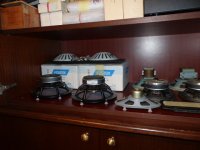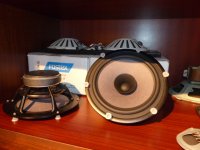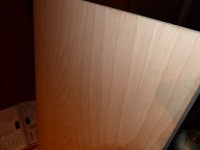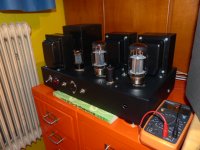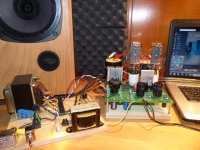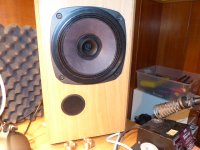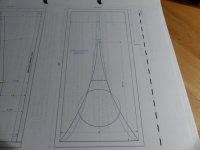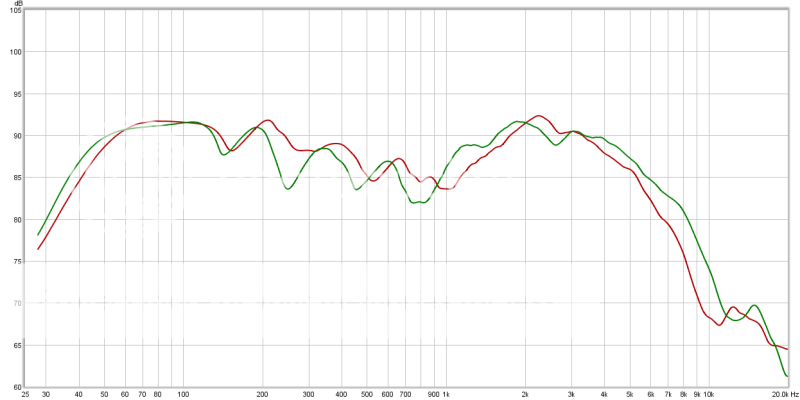Jesse, That's a really awesome job you did on those!! 😀 I like the little sub base feature. That type of base would have been typical on vintage Karlsons. Very cool.
Thanks! I can't take credit for the idea though, the bases were done that way per Freddy's request.
Jessman, are the Karlsonator's you are building the same as the ones being built for Freddi? They look very nice and I bet sound great.
Jessman, are the Karlsonator's you are building the same as the ones being built for Freddi? They look very nice and I bet sound great.
Yup, they are.
Freddi had asked what the impedance would look like with the front removed. Here is the result:
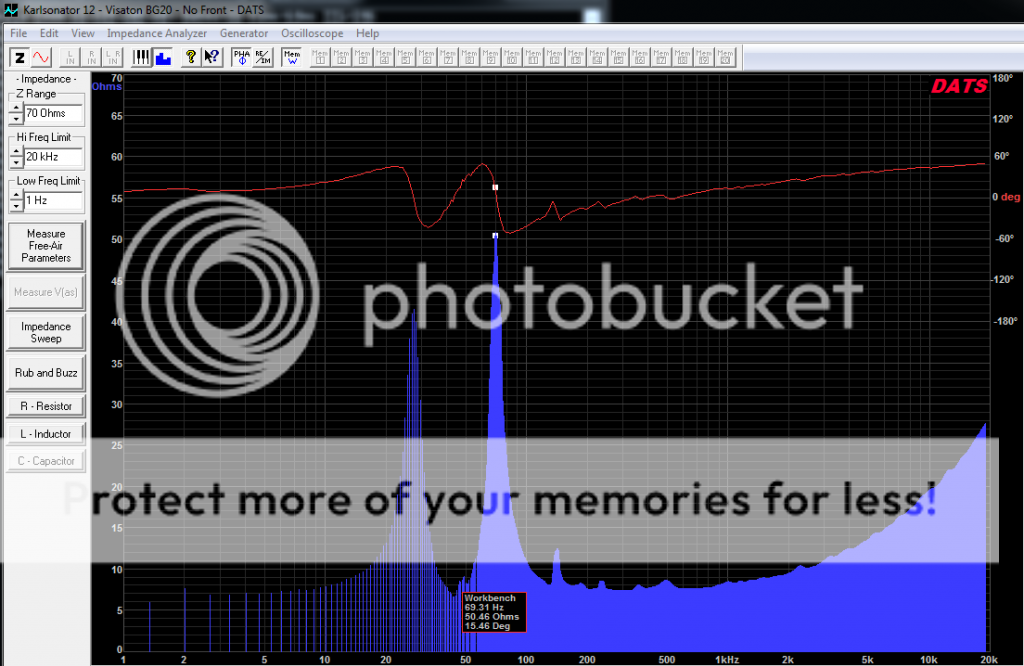
Here it is again with the front on for comparison:
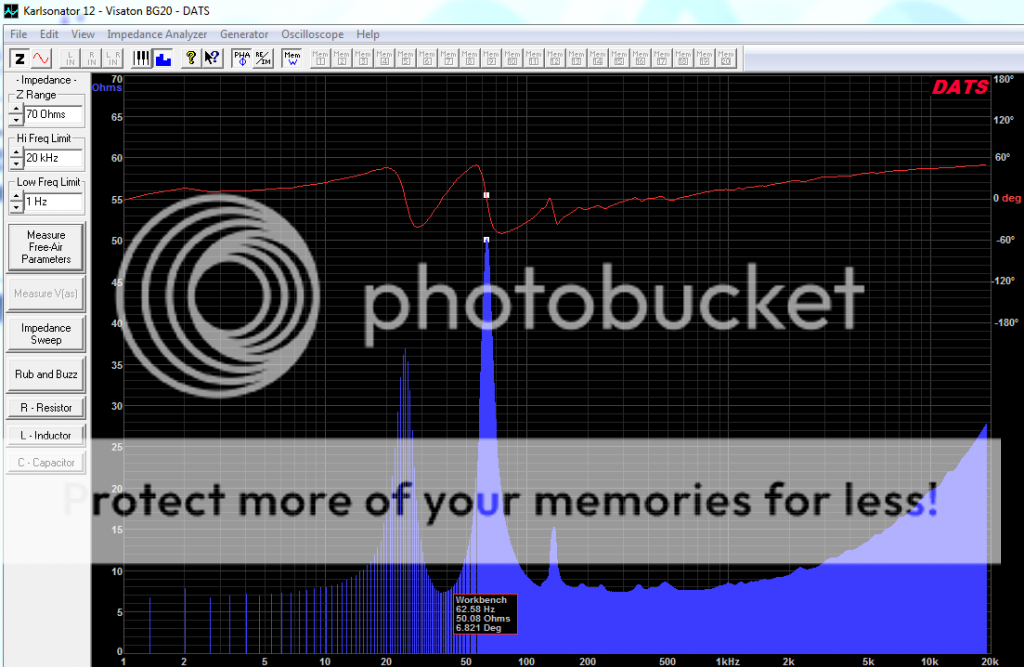
Not surprisingly, removing the front seems to shift the tuning up a bit.
looks like tuning drops from around 45 down to 38Hz - that's significant- thank you very much for the test
- that's at least 1/2 octave lower than the original Karlson 12's tuning and lower than than K15. K15 has Zmin around 48Hz but shows a near-cone null around 37Hz
although an indoor graph and in an awkward location, I think a standard K12 loaded with 8"
fullrange would have a half space F10 of around 50Hz - which is much like the low end of K15
with a 15" speaker.
BG20 in a 7-slit vent K12

- that's at least 1/2 octave lower than the original Karlson 12's tuning and lower than than K15. K15 has Zmin around 48Hz but shows a near-cone null around 37Hz
An externally hosted image should be here but it was not working when we last tested it.
although an indoor graph and in an awkward location, I think a standard K12 loaded with 8"
fullrange would have a half space F10 of around 50Hz - which is much like the low end of K15
with a 15" speaker.
BG20 in a 7-slit vent K12

Last edited:
from thejessman's impedance plots, it appears the first Karlsonator 12's tuning is about 5Hz higher than Greg B. figured in the kludged simulation.
perhaps a note can added for future builders to make the vent a bit higher "if needed" - also, an expanding initial section of the aperture slot would raise system tuning a bit a nearly constant width first six inches of aperture.
hey XRK971 - did your model hit the build's tuning on the mark? - wonder which of my 12s will best match?
here's Carl's first high aspect K8 build with my crude attempt to show the initial slot shape
-that's a Sigma 208 - the cabinet had to be rebuilt as 1/2" Baltic birch flexed too much.
the K-tube in Carl's interpretation of Karlson's X15 is an original
from the 1960's and had some sort of greenish damping compound over the aluminum tube.
for the two way user, a K-tube is "the" way to go.
Carl's later X15 builds employ a fully curved upper reflector per Fig.6 of patent 3540544

perhaps a note can added for future builders to make the vent a bit higher "if needed" - also, an expanding initial section of the aperture slot would raise system tuning a bit a nearly constant width first six inches of aperture.
hey XRK971 - did your model hit the build's tuning on the mark? - wonder which of my 12s will best match?
here's Carl's first high aspect K8 build with my crude attempt to show the initial slot shape
-that's a Sigma 208 - the cabinet had to be rebuilt as 1/2" Baltic birch flexed too much.
the K-tube in Carl's interpretation of Karlson's X15 is an original
from the 1960's and had some sort of greenish damping compound over the aluminum tube.
for the two way user, a K-tube is "the" way to go.
Carl's later X15 builds employ a fully curved upper reflector per Fig.6 of patent 3540544

Last edited:
Freddi,
My sims show the second peak at about 67 Hz and the measurement is 62 Hz, but it is very sensitive to the width of the slot at the top of the aperture and how high up that goes. I think the qualitative shape and locations of the peaks are all within 6 Hz though and that is pretty good.
My sims show the second peak at about 67 Hz and the measurement is 62 Hz, but it is very sensitive to the width of the slot at the top of the aperture and how high up that goes. I think the qualitative shape and locations of the peaks are all within 6 Hz though and that is pretty good.
that is really good correlation - the first few inches of that slot can have a lot of subjective influence. I think an upper reflector in some shorter regular K may have effects too. If a coupler is real tall and the fullrange beamy on its high end, then perhaps not a lot of HF reaches the very top of the slot (?)
Dayton PS220-8 is on sale for $90 - I think it will work well in a Karlsonator 8.
http://www.diyaudio.com/forums/full-range/256024-daytons-ps220-does-have-450hz-dip-not.html#post3921763
SPL vs Freq:
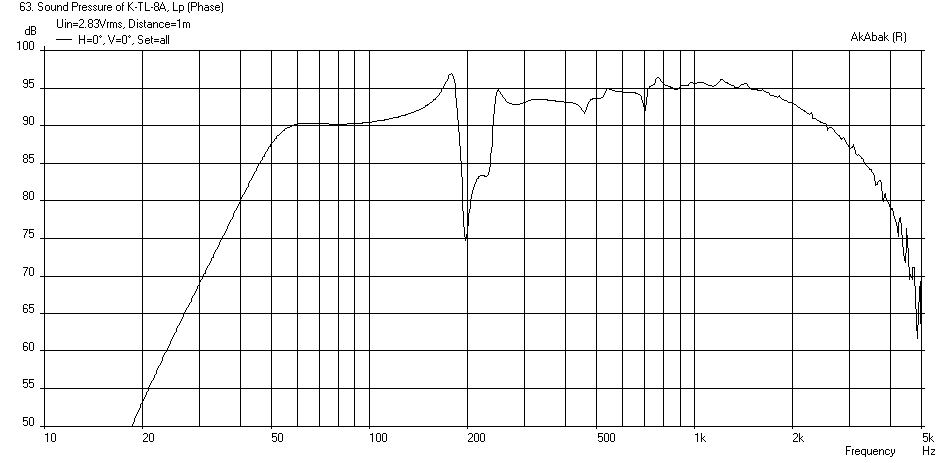
It could probably use a 6 ohm + 1.2 mH BSC to tame the rising response in line with the 90 dB bass shelf.
http://www.diyaudio.com/forums/full-range/256024-daytons-ps220-does-have-450hz-dip-not.html#post3921763
SPL vs Freq:

It could probably use a 6 ohm + 1.2 mH BSC to tame the rising response in line with the 90 dB bass shelf.
So, here we go...
Got a few sheets of really nice veneered BB, 18mm. The fostex FE203En-S are ready to go.
Seas FA22RCZ as a back up in case the fostex are 😱
If all really goes sideways the I might try my beloved Fostex 8" co-axials...
And the amps; a SE KT88 and the "naked" Tubelab SE with 300B.
Fingers crossed and if all goes to plan then the sawdust will fly next weekend!!
Got a few sheets of really nice veneered BB, 18mm. The fostex FE203En-S are ready to go.
Seas FA22RCZ as a back up in case the fostex are 😱

If all really goes sideways the I might try my beloved Fostex 8" co-axials...
And the amps; a SE KT88 and the "naked" Tubelab SE with 300B.
Fingers crossed and if all goes to plan then the sawdust will fly next weekend!!

Attachments
cool - that's good low end in both for a BG20 - interesting to see the midrange differences - it would be cool to test a more extended fullrange and maybe some 6.5 in the Karlsonator8
what was your mic distance? - did the cabinets sit on the ground? - this info will be of interest to XRK971.
here's my rather close graph of a K12 w. BG20 (with an extra vent slit) off the floor and mic pointed at the dustcap axis so it extends to 10KHz before a rolloff.
the little L. Cao F6 fullrange in a Karlsonator 6 is very extended on-axis for a design which uses no whizzer.
you can see that a classic K12 tends to ramp up response around 200Hz

what was your mic distance? - did the cabinets sit on the ground? - this info will be of interest to XRK971.
here's my rather close graph of a K12 w. BG20 (with an extra vent slit) off the floor and mic pointed at the dustcap axis so it extends to 10KHz before a rolloff.
the little L. Cao F6 fullrange in a Karlsonator 6 is very extended on-axis for a design which uses no whizzer.
you can see that a classic K12 tends to ramp up response around 200Hz

Last edited:
Jessman,
Thanks for the measurements - like Freddi said is it on the ground and how far away was the mic? The bottom end of the bass extension seems to be close to the model as well at the dip around 150 Hz but I am not capturing the mid range features in the model. I don't recall the Karlsonator 0.53x having that big of a dip at the 800 Hz range. Do you have any stuffing or foam behind the driver ? I have noticed that not having foam or felt there you can get a back wave cancellation. 800 Hz corresponds to a 8.4 inch half wave distance that may be causing destructive interference cancellation. Is that about the distance from the cone to the divider? 450 Hz dip corresponds to a 15 inch half wave path somewhere between the cone and a flat surface. That surface could use a thick layer of felt or foam. Look at the impulse response in REW and it will show you the distances.
Thanks for the measurements - like Freddi said is it on the ground and how far away was the mic? The bottom end of the bass extension seems to be close to the model as well at the dip around 150 Hz but I am not capturing the mid range features in the model. I don't recall the Karlsonator 0.53x having that big of a dip at the 800 Hz range. Do you have any stuffing or foam behind the driver ? I have noticed that not having foam or felt there you can get a back wave cancellation. 800 Hz corresponds to a 8.4 inch half wave distance that may be causing destructive interference cancellation. Is that about the distance from the cone to the divider? 450 Hz dip corresponds to a 15 inch half wave path somewhere between the cone and a flat surface. That surface could use a thick layer of felt or foam. Look at the impulse response in REW and it will show you the distances.
Last edited:
450 Hz dip corresponds to a 15 inch half wave path somewhere between the cone and a flat surface. That surface could use a thick layer of felt or foam.
The Karlsonator is 15.25" wide, and I might suspect that. 😉 Note my yet-to-be-followed suggestion (in dashed lines) to offset the driver slightly (if using a stereo pair).
FWIW damping one side of the chamber behind the driver really helped smooth the freq response of my old pair of Karlson K15 cabinets. It probably wouldn't hurt to damp one side of the front coupler section behind the wings either, but in the K15 at least, it made minimal difference in measured response.
I think that's a good result overall, especially the Karlsonator 8. That mild smiley or BBC curve is to be expected with those driver specs, but actually it is nice for background or shop speakers. The larger enclosure doesn't seem to offer any advantages for that particular driver, unless there's some quality that is audible but not obvious from measurements.
I noticed in the Karlsonator6 prototype that it sounded good when the cavity behind/above the driver was loosely filled with fluffed polyfill - it sounded somewhat muddy without the polyfil. I had one damping pad of 1" bonded Dacron on the enclosure's floor. I'm not sure if lining that cavity is as effective as fluffed polyfil.
wonder which 8" fullrange kick in the Karlsonator 8? FE206EN was the punchiest in K12
wonder which 8" fullrange kick in the Karlsonator 8? FE206EN was the punchiest in K12
Last edited:
So, here we go...
Got a few sheets of really nice veneered BB, 18mm. The fostex FE203En-S are ready to go.
Seas FA22RCZ as a back up in case the fostex are 😱
If all really goes sideways the I might try my beloved Fostex 8" co-axials...
And the amps; a SE KT88 and the "naked" Tubelab SE with 300B.
Fingers crossed and if all goes to plan then the sawdust will fly next weekend!!
Sounds great mctavish. I'm looking forward to hearing about your results. Of course, you won't know for sure until you try.
I suspect the FE203En-S might actually work well. In a way, it's a little like a front and rear loaded horn. If carefully treated, the front chamber could be used to smooth out the driver's rising frequency response. You may want to consider lining the backs of the wings with felt or something. I'm fiddling around with this now, and it seems to be quite effective for smoothing out bright drivers in smaller Karlson type boxes.
Is that a Fostex craft book hiding beneath your amplifier??😀
lol - I'd have 10 coats of shellac * in the front chamber and on the inside of the wings. Carl would have that plus a curved chamber. Jesse - what mic did you use? - it looks a little bit off the ~28 degree tilted axis where the highs beam pretty much straight on-axis from the dustcap/whizzer. The most extended HF response is down that line. (* felt is probably useful to reduce slap and energy storage)
Yeah, we've been arguing about this for 10+ years now I think, and we probably aren't going to start agreeing now... 😀 I guess the truth is that taste varies. 😉
In the K15 (with unfinished plywood interior), I didn't find the slap echo objectionable or even audible, but as the front chambers get scaled down in smaller K types, the coloration gets progessively more audible.
To my ears, the best solution is to make the interiors progessively less reflective in proportion to the reduction in size. I'm sure the DIYers of this forum are smart enough to experiment and decide what is best for their ears.
In the K15 (with unfinished plywood interior), I didn't find the slap echo objectionable or even audible, but as the front chambers get scaled down in smaller K types, the coloration gets progessively more audible.
To my ears, the best solution is to make the interiors progessively less reflective in proportion to the reduction in size. I'm sure the DIYers of this forum are smart enough to experiment and decide what is best for their ears.
Here is a shot of where/how I was measuring:

The mic is a Dayton UMM-6, it was about three feet away, sitting about 18" off the ground and was pointed able 6" above the driver.
The Karlsonator 8 is lined with felt behind the driver where as the Karlsonator 12 is bare. That would probably explain some of the uneven response at 450 and 800 Hz.

The mic is a Dayton UMM-6, it was about three feet away, sitting about 18" off the ground and was pointed able 6" above the driver.
The Karlsonator 8 is lined with felt behind the driver where as the Karlsonator 12 is bare. That would probably explain some of the uneven response at 450 and 800 Hz.
Last edited:
- Home
- Loudspeakers
- Full Range
- Mini Karlsonator (0.53X) with Dual TC9FDs

